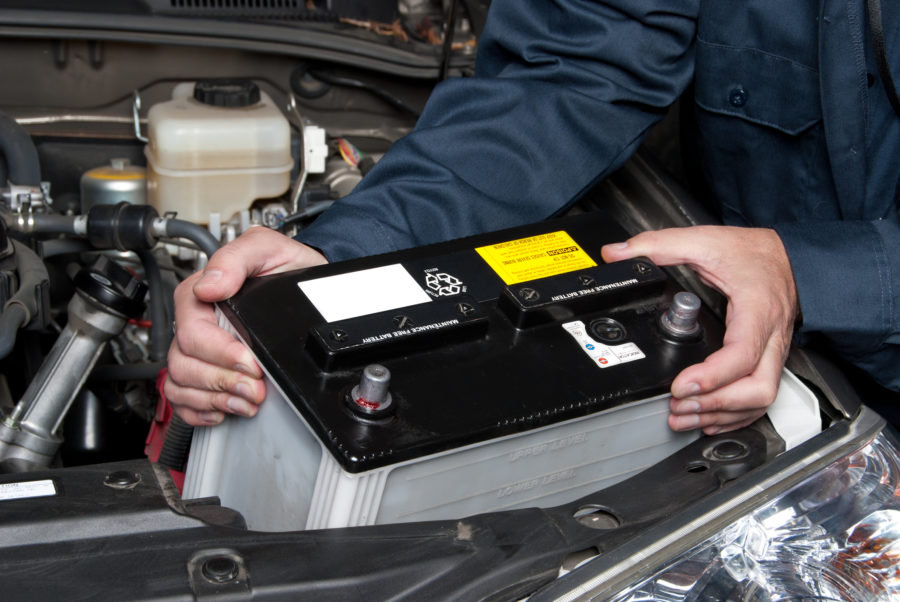If the engine is the heart of a car, the battery is the brain. It’s used to power almost everything, from the initial starting of the engine, to your lights, your heating and your music. So it’s important that you keep your car battery in good working order.

How Long Does A Car Battery Last?
A car battery can last for up to five years. But that’s not to say that you should leave five years between testing them.
Certain things can put a strain on your car battery. For example, you’ll put a lot of demand on it during winter, as you’ll be using systems like lighting and heating a lot more.
Cold weather can reduce the life of your car battery too, as low temperatures can affect the chemical reactions necessary to make it work. This is a major reason why breakdowns are more common in winter, and why you may sometimes have trouble starting your engine on freezing mornings.
Hot weather can also negatively affect your battery’s lifespan, as high temperatures can cause the battery’s electrolyte to slowly evaporate. If these fluid levels get too low, the battery’s internal plates can become damaged, and it will produce less voltage.
You should check your car’s battery regularly, and not just when it’s starting to cause you problems. Like all aspects of motoring, it’s safer and more affordable to stay on top of things. If you routinely check your battery, you can prevent problems long in advance.
How Often Should You Check Your Car Battery?
You should aim to check your car battery at least twice a year. Your mechanic will test your battery during routine servicing and as part of your annual MOT test, but you can check it yourself between garage visits.
Many car batteries have their own charge indicator. Look for a sight on the top of your battery. If it’s fully charged, it will usually display a green dot. If it’s faulty, it will usually display a yellow dot. If it’s in need of a charge, no colour will be visible. Most cars also display a dashboard warning when your battery’s getting low.
To check your car battery, you need a device called a voltmeter, or a multimeter.
How to Check Your Car Battery with a Multimeter
- Test your battery after it’s been idle for a while – preferably first thing in the morning when your car’s been parked overnight. This way, you’ll get your car’s “resting voltage”, which will give you a good indication of its overall health.
- Locate your car battery – it will usually be found to one side of your engine.
- Make sure you can access your battery terminals – some batteries have plastic covers that you can simply lift off, but you may have to undo some bolts.
- Set the multimeter dial to 20 DC volts.
- Most multimeters come with red probes and black probes. Hold the red probe to your batteries positive (+) terminal, and the black probe to the negative (-) terminal.
If the reading is higher than 12.6 volts, then congratulations! Your battery is charged. If you get anything less than 12 volts, then it’s time to get your battery charged.
How to Charge Your Car Battery
Bear in mind that you should not charge leaky or damaged car batteries. If your car battery is reaching the end of its life cycle, you might be better simply getting a replacement than charging it.
You can buy your own car battery charger from most good auto shops. The main thing is to ensure that the charger is suitable for your car’s specific battery. After this, it’s simply a case of first disconnecting your battery, connecting the right cables to the right terminals, plugging in your charger to the mains, and away you go.
There are a few things to bear in mind, though. First, disconnecting your car battery can be dangerous if not done right. To prevent electrical shock, disconnect the negative lead first, and reconnect it last. Also take care not to spill any of the battery’s electrolyte. This is a mixture of acid and water, and it can be corrosive.
Second, unless you follow the charger’s instructions to the letter, you might end up damaging your battery. For example, some chargers will switch themselves off when the battery is fully charged, while others will require you to do it yourself. Needless to say, you don’t want to overcharge your battery…
Finally, car battery chargers aren’t exactly cheap. If your car battery’s failing, it might be more cost effective, and less risky, to simply take your car to the garage.
Make sure help is at hand
If your car battery dies when you’re out and about, you won’t be able to start your car. If your battery’s faulty, it could affect key systems like your lighting and wipers. That’s why it’s always a good idea to consider taking out breakdown cover when you buy insurance as a new driver.


